 Last additions Last additions |

End of the walk. Again we dip our feet in salt. We all ended up with muddy feet. There was no place to wash our feet either. Bringing wet tissues is highly recommended if you plan to walk on the fire.Mar 16, 2005
|
|

This is what it looked like by the time we got there. Hardly any fire. It was somewhat wet, and it did not feel hot or warm at all. Pretty disappointing...This is what it looked like by the time we got there. Hardly any fire. It was somewhat wet, and it did not feel hot or warm at all. Pretty disappointing...Mar 16, 2005
|
|

Then we stick our feet in salt.Mar 16, 2005
|
|

First we pass through a gauntlet of chanters.Mar 16, 2005
|
|

Mar 16, 2005
|
|

Everyone crosses barefoot, so we took off our shoes as we approached the fire crossing.Mar 16, 2005
|
|

End of the line. It reads, "Saikobi."Mar 16, 2005
|
|

After the priests, the general public is invited to stand in line and cross the fire for free.Mar 16, 2005
|
|

Long line: It took us over 30 minutes to reach the fire.Mar 16, 2005
|
|

I always wondered how hot it was to walk on the fire, so this time I decided to walk over the fire just to see how much heat my feet could bear. Also see the video at YouTube.Mar 16, 2005
|
|
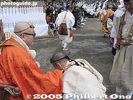
After crossing the fire, each person is blessed by the head priest with a tap on the shoulder by a baton.Mar 16, 2005
|
|

Hiwatari fire-crossing festival, Mt. Takao, TokyoMar 16, 2005
|
|

Walking on fireMar 16, 2005
|
|

Before and after walking over the fire, they stick their feet into a pile of salt.Mar 16, 2005
|
|

First the priests walked on the fire.Mar 16, 2005
|
|

Blessing the pathMar 16, 2005
|
|

This priest splashed the boiling contents of this pot over himself.Mar 16, 2005
|
|

Head priestMar 16, 2005
|
|

Mar 16, 2005
|
|

Raking the fireMar 16, 2005
|
|

Mar 16, 2005
|
|

Raking the fire. They are making the footpath for fire walkers.Mar 16, 2005
|
|

Mar 16, 2005
|
|

Mar 16, 2005
|
|

She was tossing out these paper things to the crowd.Mar 16, 2005
|
|

Mar 16, 2005
|
|

The pile catches fire very easily due to the kerosene. Even at this distance, it gets very hot. Also see the video at YouTube.Mar 16, 2005
|
|

Mar 16, 2005
|
|

Dai-hiwatari Festival, Mt. Takao, TokyoMar 16, 2005
|
|

Mar 16, 2005
|
|

The pile is first ignited from two sides.Mar 16, 2005
|
|

This long torch will be used to ignite the pile.Mar 16, 2005
|
|

He shoots an arrow into the pile from the four corners.Mar 16, 2005
|
|

Divine arrow to ward off any life-threatening devils. The festival is executed by the mountain ascetic priests called yamabushi.
Mar 16, 2005
|
|

Various ceremonies, rituals, and chanting takes place during one hour from 1 pm. Divine ax used to cut away earthly desires.Mar 16, 2005
|
|

The name of the festival is "Hiwatari," literally meaning fire crossing. They make a big fire, then allow people to walk over the embers. This is the centerpiece of the festival, a pile of cypress tree branches to be burned.Mar 16, 2005
|
|

This festival is held on the second Sunday every March at the foot of Mt. Takao. It takes less than an hour from Shinjuku via the Keio Line. Train fare is only 370 yen. The pile of tree branches is supported by a wooden framework. A priest pours kerosene.Mar 16, 2005
|
|

The festival site is a short walk from Takao-san-guchi Station. It's held in this large lot cordoned off by a sacred rope. This festival is held as a prayer for traffic safety, household safety, and personal safety. It is held by the Yakuoin Yukiji Te
Mar 16, 2005
|
|

Yotsukaido Station is on the JR Sobu Line on the way to Narita Airport. Map: http://www.kanko.chuo.chiba.jp/c_event/5705/Feb 27, 2005
|
|

Feb 27, 2005
|
|

The End(s)Feb 27, 2005
|
|

I can't see... That's what he said: "Mienai" The kids nearby were screaming with laughter.Feb 27, 2005
|
|

Warm UpFeb 27, 2005
|
|

Feb 27, 2005
|
|

Feb 27, 2005
|
|
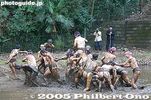
Feb 27, 2005
|
|

Feb 27, 2005
|
|

Mud SlingingFeb 27, 2005
|
|

Feb 27, 2005
|
|

Mud Fight Round 2Feb 27, 2005
|
|

New Status Symbol at Warabi Hadaka Matsuri in Yotsukaido, Chiba.Feb 27, 2005
|
|

Mud Brings Happiness, at Warabi Hadaka Matsuri in Yotsukaido, Chiba.Feb 27, 2005
|
|

After warming up at the fire, they run back to the mud.Feb 27, 2005
|
|

Mud on Your Face: Fashionable, at Warabi Hadaka Matsuri in Yotsukaido, Chiba.Feb 27, 2005
|
|

Mud for All AgesFeb 27, 2005
|
|

Keep in mind that this is in the middle of winter.Feb 27, 2005
|
|

A Touch of Mud. One custom is to receive a touch of mud on your face.Feb 27, 2005
|
|

They are in the mud for only a few minutes. Then they go back up to the shrine nearby and warm up near a fire. They go back and forth between the shrine and mud paddy about 4 or 5 times.Feb 27, 2005
|
|

Feb 27, 2005
|
|

Mud Fight. After clashing and crashing to the mud, they throw mud at each other.Feb 27, 2005
|
|

Mud FightFeb 27, 2005
|
|

The festival is also nicknamed "Doronko Matsuri" which means Mud Festival.Feb 27, 2005
|
|

Some babies wear beautiful kimono for the occasion.Feb 27, 2005
|
|

All the baby-carrying men must be careful not to slip and fall in the mud. Warabi Hadaka Matsuri in Yotsukaido, Chiba.Feb 27, 2005
|
|

Sacred Water (and Mud). On the the left, the water feeding the paddy is enclosed by a sacred rope. This makes the water (and mud) sacred.Feb 27, 2005
|
|

Mud Spotting, Warabi Hadaka Matsuri in Yotsukaido, Chiba. The men hold babies and use mud to paint a mud spot on the baby's face. It is to wish for happiness for the baby.Feb 27, 2005
|
|

Feb 27, 2005
|
|

Feb 27, 2005
|
|

Babies to Mud at Warabi Hadaka Matsuri in Yotsukaido, Chiba. The men carry babies to the mud paddy and use a straw strand to paint a dot on the baby. Sometimes they use a finger to do it.Feb 27, 2005
|
|

A Man and a Baby at Warabi Hadaka Matsuri in Yotsukaido, Chiba.Feb 27, 2005
|
|

Men Take Strands of StrawFeb 27, 2005
|
|

Mimusubi Shrine, Yotsukaido, Chiba. The small shrine that conducts the festival. (皇産霊神社)Feb 27, 2005
|
|

Baby Blessings at Warabi Hadaka Matsuri in Yotsukaido, Chiba. Infants are blessed in front of the shrine.Feb 27, 2005
|
|
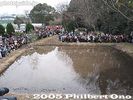
Mud Paddy. Main site of the Warabi Hadaka Matsuri held every Feb. 25.Feb 27, 2005
|
|

No wind. This flight lasted only about 30 sec. We ran about 50 meters, then the kite fell back to Earth. Also see the video at YouTube.Jul 14, 2004
|
|

Higher and higher...It went up to about ?? meters.Jul 14, 2004
|
|

Festival posterJul 14, 2004
|
|

Yokaichi Odako giant kite Air borneJul 14, 2004
|
|

And lift off...Jul 14, 2004
|
|

Yokaichi giant kite coming up.Jul 14, 2004
|
|
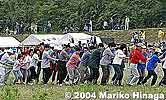
OK, RUN NOW!! This is the most exciting part when we start running with the rope. It was like a stampede, and I let go after a few seconds to avoid getting runned over by the mob behind me.Jul 14, 2004
|
|
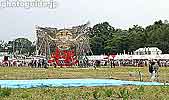
100 kite pullersJul 14, 2004
|
|

Giant Kite sake. The food and souvenir booths sold a variety of merchandise including this locally-brewed sake, complete with a label showing this year's kite design.Jul 14, 2004
|
|

Kite pullers wanted. This booth, next to the giant kite, is where you can apply to pull the kite. Anybody can apply to pull the giant kite. I applied and got a little kite pin and a pair of gloves.Jul 14, 2004
|
|
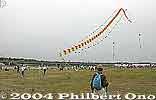
Kite train or "rendako." These kites are pretty to watch. 連凧Jul 14, 2004
|
|

Ready for another flightJul 14, 2004
|
|

Mini kite flying contestJul 14, 2004
|
|

Sagamihara kite in flight. Due to a lack of wind, this flight didn't last long.Jul 14, 2004
|
|

Sagamihara kite team invited. Sagamihara city in Kanagawa Prefecture also has a giant kite festival, and they were invited to fly a smaller version of their kite at Yokaichi. (Yokaichi was also invited to Sagamihara's kite festival in April.)Jul 14, 2004
|
|
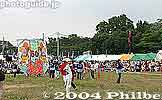
Mini kite flying contest. The flying portion of the kite contest is held.Jul 14, 2004
|
|

Banzai from Sagamihara. After the kite's flight, the Sagamihara team give a few banzais to themselves and to Yokaichi.Jul 14, 2004
|
|
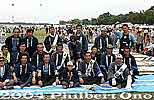
Yokaichi Giant Kite Preservation Society. This is the group responsible for producing, maintaining, and flying the giant kite. 大凧保存会Jul 14, 2004
|
|

Snapped part being repaired.Jul 14, 2004
|
|

Take off. On cue, the people pulling the kite start running and the kite starts to lift off. Also see the video at YouTube.Jul 14, 2004
|
|

Raising the kite. Long bamboo poles are used to prop the huge kite upward to meet the wind.Jul 14, 2004
|
|

Kite cornerJul 14, 2004
|
|
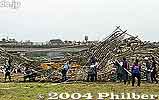
Launch pad. The kite is carried to the take off point and pointed toward the wind, which unfortunately very weak this day.Jul 14, 2004
|
|

Ready for flightJul 14, 2004
|
|

Stringing the kiteJul 14, 2004
|
|

Carved paperJul 14, 2004
|
|

People's fortune stickers on the kite. 願い札Jul 14, 2004
|
|
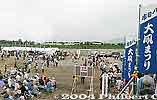
I saw the Yokaichi Giant Kite Festival (Odako Matsuri) for the first time on May 23, 2004. The site is alongside the Echigawa River near the Yachiyo Bridge. A free shuttle bus from Yokaichi Station is provided, taking about 10 min. Jul 14, 2004
|
|

The Big One. The size is equivalent to 100 tatami mats or about 12 meters x 13 meters (156 square meters).Jul 14, 2004
|
|

CrowdsJul 14, 2004
|
|

Mini kite contest. Kite contestants show off their kite designs at their tents.Jul 14, 2004
|
|

KnockersWhen they carry the mikoshi, a pair of knockers on both sides the mikoshi are struck to make a rhythmic sound.Jul 12, 2004
|
|

Jul 12, 2004
|
|

Parading along a shopping streetJul 12, 2004
|
|

Koyurugi ShrineJul 12, 2004
|
|

Koyurugi Shrine lookoutThe shrine is built atop a cliff overlooking the ocean, and there's small lookout offering sweeping view with Enoshima in the distance.Jul 12, 2004
|
|

Enoshima from Koyurugi Shrine lookoutJul 12, 2004
|
|

Secondary shrinesJul 12, 2004
|
|

Entrance to Koyurugi ShrineIt is dedicated to the sea goddess.Jul 12, 2004
|
|

Streetcar breakJul 12, 2004
|
|

Mikoshi face-offThe shrine from Yasaka Shrine on Enoshima is the male (left), and the mikoshi from Koyurugi Shrine (foreground) is female.Jul 12, 2004
|
|

Tram breakPart of the procession route also happened to be the Enoden streetcar route so we had to make way for the passing streetcar every 15 min. or so. There were streetcar personnel who blew their loud whistles whenever a streetcar was to pass through. I got scolded for sticking out my head to take this shot. Jul 12, 2004
|
|
|
|

Passing by Ryukoji TempleJul 12, 2004
|
|

Passing Enoshima StationJul 12, 2004
|
|

Jul 12, 2004
|
|

Jul 12, 2004
|
|

Crossing overJul 12, 2004
|
|

Mikoshi made of acornsJul 12, 2004
|
|

Jul 12, 2004
|
|

Enoshima's main dragJul 12, 2004
|
|

Jul 12, 2004
|
|

Entrance to Yasaka ShrineJul 12, 2004
|
|

Jul 12, 2004
|
|

Jul 12, 2004
|
|

Jul 12, 2004
|
|

Jul 12, 2004
|
|

Jul 12, 2004
|
|

Blessings at seaThe mikoshi and bearers are blessed by a shrine priest on a boat wielding a sacred staff.Jul 12, 2004
|
|

At seaShrine helpers on a boat splash buckets of sea water on the mikoshi bearers.Jul 12, 2004
|
|
|

Down rampJul 12, 2004
|
|

Jul 12, 2004
|
|

Water's edgeJul 12, 2004
|
|

Jul 12, 2004
|
|

Jul 12, 2004
|
|

Jul 12, 2004
|
|

Entrance to Enoshima's main drag. After you pass through this torii, you walk uphill along a narrow road lined with tourist souvenir shops.Jul 12, 2004
|
|

Jul 12, 2004
|
|

Jul 12, 2004
|
|

Preparing for the seaDuring a break, the mikoshi is prepared for a run in the ocean.Jul 12, 2004
|
|

Jul 12, 2004
|
|

Tengu manIn the searing heat of summer, this costume must be unbearable.Jul 12, 2004
|
|

Jul 12, 2004
|
|

The festival is actually held from the first to second Sunday in July. Eighth day is the main day.The festival procession comes toward Enoshima's gateway which is the Seido no Torii (青銅の鳥居) gate.
This day-long festival starts at 9:30 am at Enoshima's Hetsunomiya Shrine. A large mikoshi (portable shrine) from Yasaka Shrine is carried from the shrine to Koyuguri Shrine on the mainland. Along the way, the mikoshi is carried into the ocean. On the mainland, the Yasaka mikoshi is met with a mikoshi from Koyuguri Shrine. They then parade together along a shopping street before the Yasaka mikoshi goes back to Enoshima at around 6 pm.Jul 12, 2004
|
|

Bridge to Enoshima. Two bridges, one for vehicles and the other for pedestrians, enable access to this small and charming island.Jul 12, 2004
|
|
|
|
| 71466 files on 284 page(s) |
 |
 |
 |
 |
284 |
|